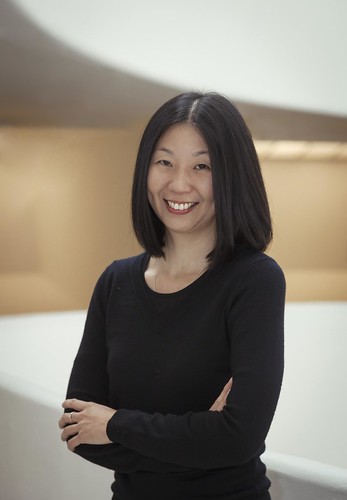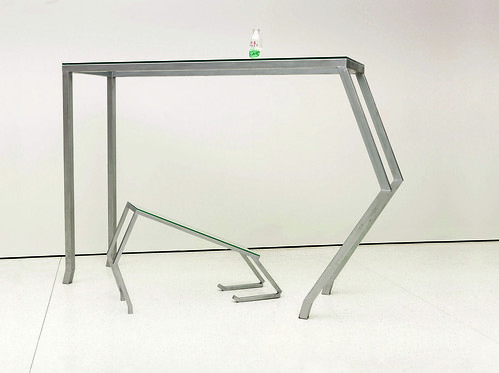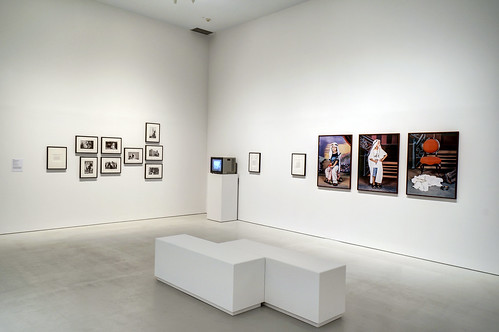The Guggenheim UBS MAP Global Art Initiative was launched last year in New York with the exhibition No Country: Contemporary Art for South and Southeast Asia. The exhibition first travelled to Hong Kong in October 2013 and is now in Singapore on the last leg of its tour where the show will run at the Centre for Contemporary Art (CCA) at Gillman Barracks till July 20, 2014. Artitute writers Durriya Dohadwala and Riya de los Reyes met Singaporean curator, June Yap, and asked her a few questions about the exhibition.

June Yap
Guggenheim UBS MAP Curator, South and Southeast Asia
Photograph by David Heald
©Solomon R Guggenheim Foundation, NY
Artitute (A): The subtitle of the exhibition is “Contemporary Art for Southeast Asia and South Asia”. Why ‘for’ and not ‘from’? Is there a particular reason for it?
June Yap (JY): It is a deliberate choice of prepositions. Because when you look at the project broadly, on the one hand you could look at it using the word from or of, and it becomes representation. It becomes one side looking at the other. But when you use the word for, it suggests reciprocation. It suggests care for the other side, and a consciousness of oneself but also the other and that was something that I felt was very important in a project like this. It was a conversation that went two ways and not just about oneself but also the other.
A: And how is this reflected, this two sidedness and the intended reciprocal relationship?
JY: The engagement of the artists is very much embedded in that they are bringing to life through their work the kind of subjects that they portray are not impersonal. They are over-engaged and very committed and that is something that relates to the title as well.
A: With regards to the exhibition’s theme—from W.B. Yeat’s poem Sailing to Byzantium to Cormac McCarthy’s novel No Country for Old Men and then the 2007 Hollywood movie of the same name—is there a particular aspect from any one of them that you capture in the exhibition?
JY: The poem itself looks at very universal themes—about being, mortality and morality. These are topics that anyone, everyone can identify with, and these topics are adapted across the different media. These accessible topics are recognizable in the artworks, which I see as extensions of the previous media adaptations (of the poem). It is basically about the subject of knowledge, in particular surrounding the quote “unageing intellect”, and how we have lost consciousness of what we can learn from the past. You have the film’s contemporary setting where you see themes that are historical but portrayed in a contemporary form. This is a different take from the novel, but the themes are present and it’s the same for this exhibition.
A: What about how the film and the novel portray the way we look at the West, for instance?
JY: Well, there is also that. The poem inspired an Irish-American writer whose novel was then adapted as an American film for contemporary audiences, and now it sets the tone for an exhibition on South and Southeast Asian art. I suppose the point is that these places are not so far apart [in experiencing the themes of the poem], and how the themes are transferrable and indeed universal, regardless of geographical situation or cultural contexts.
A: What was the reason for putting Southeast and South Asia together? In the past, South Asia has usually been shown together with the Middle East. By conflating national identities (mostly previously colonial) into two regions of South and Southeast Asia, does the exhibition want to highlight the similarities or differences between the art practitioners of the two regions?
JY: Well, South and Southeast Asia as the exhibition’s focus was defined before I entered the project, and I was aware of it. For me, it was very interesting too because when we look at Southeast Asia, we have a very strong connection with South Asia and often we neglect that. In a way, this is an opportunity for us to bring back that alliance, rediscover that certain affinities that are there but perhaps in an economic sense or cultural sense we draw these lines, which are really quite arbitrary. Because if you look at South and Southeast Asia, even drawing the line around that region is quite difficult; we can go all the way to Afghanistan and then to East Timor and [it is still impossible to accurately demarcate the boundaries of the region]. So, you can talk about colonial issues and how these lines were drawn. Through their works, artists like Navin Rawanchaikul bring something more weighty and consequential, so as to open up topics that would otherwise have been narrow and parochial.

Navin Rawanchaikul_Places of Rebirth_2009
A: Prasenjit Duara recently spoke about conceptualizing Asia as “a network rather than geographical entities”. That can be seen in your choice of artworks, which explore the fluidity of identities and the idea that Southeast Asia and South Asia do not exist in a vacuum.
JY: Yeah, but these are ideas that actually go back really far. There is an essay somewhere, that had a reference to Ernest Renan who, in a lecture in 1882 entitled What is a Nation?, was already questioning ethno-linguistic definitions. So that goes back to what Prasenjit was talking about and to Homi Bhabha as well. But the theory and the reality are quite different. In reality, and sometimes in culture as well, geographical and national entities sometimes end up reinforcing themselves rather than allowing for the fluidity to come forth and be explored.
A: Following from that, how did you choose the artists then? Was there a particular criteria to choosing the artworks that were eventually included in the exhibition?
JY: What I am drawn to is critical work. Works that look or challenge or look at questions and manage to articulate a wider range of possibilities. These works conform to that, but at the same time the works are for a collection so these are artists who have significant practices and that was one of the main criteria when making decisions about artist and artworks. And then the third layer is really the idea of the exhibition itself. The exhibition allows for me to emphasize or say with an accent across the work and therefore create this narrative that runs in parallel.
But that doesn’t mean that it defines the work in itself. Each of the work has a lot more than it encapsulates, but I am drawing on one aspect in order to link them and create an exhibition. For me, being part of the collection means that I was sensitive to the fact that the works can be juxtaposed with other artworks and create other conversations. And that was instrumental in how they were selected, so it was also that and not just on the basis of them being critical works or based on a particular curatorial strategy.
A: What was the curatorial structure and process for the selection of works and artists? As the region is vast and a large number of countries are included in the exhibition, did you have a network of curators that you drew upon? Who were they? Within each country there are multiple art practices, styles, and within a country there can be vast differences in the art of the regions. What was the overall process like?
JY: Well, I have been working on the region for quite some time so some of this is a result of that earlier research and connections. But in order to gather all the research, there were a lot of artists, writers, and curators whom I knew. I was looking for certain type of combinations of ideas towards the eventual concept.
A: In the West art from Pakistan generally tends to be focused on miniature painting practices and it has been so in Singapore too. It seems to define Pakistani contemporary art. You have chosen Bani Abidi for this exhibition and it gives another angle to art practices in Pakistan. Was that intentional? Can you comment about this?
JY: Yes, I was looking at various developments in different parts of each of the countries and they are quite different from each other. When it comes to Pakistan, yes, miniature painting is the thing. Everyone learns it and we do have Khadim Ali in the collection who does miniature painting. But his miniatures are blown up paintings and his approach is quite different. So I wanted to have that aspect as context too.

Bani Abidi,The Boy Who Got Tired of Posing (from The Boy Who Got Tired of Posing), 2006
A: Your choices of artworks from the Philippines are also very interesting. The Philippines is sort of an anomaly in Southeast Asia, and even more so if seen in relation to South Asia. Could you describe in one sentence what your criteria was in choosing the artworks in the exhibition?
JY: Well, it was not just about linking the two artworks. Both of them have very strong practice and that was something that was important for the collection. For Norberto, his artworks are actually quite political and quite subtle and confrontational, so it harks back to the times when he was more politically active. As for Poklong, his artwork brings a different kind of aesthetic. His artwork is really very subtle. His interventions are almost intangible, sometimes unnoticed as well. And I find that this leads to questions of how contemporary art practices may overemphasize certain identities or positions. Even then, I would not say my two choices are definitive of art in the Philippines. I know a lot of artists there doing amazing work, but unfortunately, the exhibition was limited. They were chosen separately and for different reasons, which was the same way that we approached the choice of artworks from other countries in relation to the different cultural narratives that have been written, and how the artistic practices have developed and been produced. So the artworks were not chosen purely for the themes that they explored, but more for these other reasons.
A: Where is Singapore situated in this? Could we say that Singapore is positioned as the one facilitating the action that manifests the ‘for’ in the title?
JY: Across the board, it is more between the US and—since UBS is a Swiss bank—Europe. It is for Asia, with Europe and America on the other hand. The ‘for’ in the subtitle refers to the sense of very immediate reciprocation and exchange of ideas and mutual understanding. For Singapore, well it is geographically here in Southeast Asia, and we also have a couple of artists in the exhibition, Tang Da Wu and Ho Tzu Nyen.

Tang Da Wu (b. 1943) Our Children, 2012
A: The choice of certain works by such a prestigious exhibition indirectly signals to the viewers and artists what is being valued. Do you think your choice of works will have an effect on future art production and exhibition? When you have an exhibition of this size, do you think it signals a direction?
JY: In some ways…yes. I think it will signal a direction but not the direction. There are other effective influences also—political or economic, and certain countries do not have as much visibility. So this is one opportunity to perhaps—I won’t say entirely to balance it out—but at least allow for shifting it a little bit.
A: While a lot of the works may have been new to the US, many of the artists and artworks that are in the exhibition have been seen here before. Do you think that will affect the reception of the exhibition here?
JY: I think with contemporary art we are used to having the most spectacular… being the first or “oh, you have to have the first look”, as if you will never look at it again. That’s not really the case for art. If you take the case of a museum like MOMA, you still go back to the modernist works but not because you have not seen them before. You have seen them millions of times. It’s like a river; you never quite cross the river twice and seeing the works again you might notice something different each time and for me, that is important. That we also look at art not as a fad or trend but as something deeper than that, something renewable but also lasting. You see something new every time.
A: What about the response from the West? How would you describe how the exhibition has been received?
JY: It is very much a conversation. On the one hand, with the artists and their individual contexts, and what they are trying to do and then bringing that back to the museum—to see what resonates from these conversations. There is that negotiation of ideas and concepts and understanding. The responses have been very varied and positive for the museum, which is quite nice. There is a passion in these artworks and that passion is real. They are able to communicate that by going beyond mere representation.
A: Do the works go anywhere else from here?
JY: This is the last stop. After this the works go back to the collection in Guggenheim. This means that the works will be juxtaposed with other works in the future, which is exciting.
A: Did you have to revise the works as they travel?
JY: For practical reasons, we naturally had to change some things but otherwise the concept, everything, remains intact.
A: If you were to pick one work that embodies the exhibition which one would that be?
JY: never answer that question. I really, really like them all!
By: Durriya Dohadwala and Riya de los Reyes
About Artitute’s writers;
Riya de los Reyes is a freelance writer on contemporary Asian art and culture. She currently works at a publishing house and was an alumni of the Curating Lab Programme (2012).
Durriya Dohadwala is an independent writer on contemporary Asian art and culture. She is also a docent and enjoys facilitating the decoding of contemporary Asian art.

Artitute
is an online showcase and magazine covering Southeast Asia’s established and emerging visual artists and art scenes.

